| May 1, 2007
A Ghost at the Keyboard?
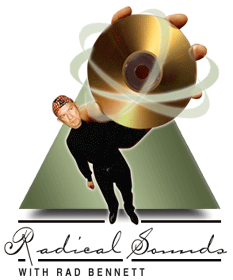 In the early 20th century, many
famous pianists made piano-roll recordings of their versions of familiar masterworks, many
of which were copied to LP and, later, to CD, using modern player pianos and high-fidelity
recording techniques. Two of the best of these CDs, released by Telarc a few years ago,
captured Rachmaninoff playing his own music and that of others. Advanced transfer
techniques permitted nuances in the playing that defied the basic logic of merely
duplicating piano-roll performance on CD. In the early 20th century, many
famous pianists made piano-roll recordings of their versions of familiar masterworks, many
of which were copied to LP and, later, to CD, using modern player pianos and high-fidelity
recording techniques. Two of the best of these CDs, released by Telarc a few years ago,
captured Rachmaninoff playing his own music and that of others. Advanced transfer
techniques permitted nuances in the playing that defied the basic logic of merely
duplicating piano-roll performance on CD.
Now, on a multichannel SACD/CD, Sony Classical has teamed
with Zenph Studios in a project light-years ahead of Telarc’s Rachmaninoff discs.
They have somehow computerized Glenn Gould’s famous 1954 recording of Bach’s Goldberg
Variations and transferred it to a special Yamaha piano, then recorded it in SACD. The
disc also contains a second recording done in true binaural two-channel sound. I
don’t have headphones, and so couldn’t really evaluate that recording. (By the
way, you have to switch your SACD player out of multichannel mode before you can access
those tracks.)
Zenph calls the results a "re-performance." It
does sound like good playing, but is it Gould, at a keyboard again more than 50 years
after the original recording? The rapid tempos are astonishing, à la Gould, but they come
from the sound of a Yamaha piano in a contemporary studio, so the results sound a bit
"fatter" to me than the original. Still, it’s very musical, and whoever is
playing it, man or machine, it sounds not in the least contrived or manipulated, and
recorded in very good SACD sound. Listeners will no doubt devote many hours to fighting
over the right or wrong of this. I enjoyed it with strong reservations.
Here are six new, less controversial SACDs and one
DVD-Audio disc.
Spain
Falla: El Amor Brujo; The Three-Cornered Hat: Suite; La
Vida Breve: Interlude and Dance
Granados: Goyescas: Intermezzo
Albéniz: Ibéria: Triana, El Corpus Christi en Sevilla, Navarra
Leontyne Price, soprano; Chicago Symphony; Fritz Reiner conductor.
RCA Living Stereo 88697-04607, Hybrid Multichannel SACD.
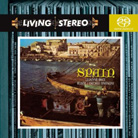 Based on Fritz Reiner’s few
recordings of Spanish music, the Hungarian-born conductor had a real flair for Spanish
rhythms and colors: these performances sizzle. I’ve always felt that Spain,
recorded in 1958, was one of the very best-sounding of RCA’s distinguished Living
Stereo sessions, and hearing it in this first-ever release of its original three-channel
master confirms that impression. The orchestra is spread naturally from left to right,
with good stage depth. Yet every instrument, no matter how close to or how far from a
microphone, has undeniable presence. The strings sound warm (purists might say they sound
"analog," with lots of air around them), and the various percussion instruments
employed come through with singular clarity. Falla’s El Amor Brujo, recorded
in 1963, is no less successful. Leontyne Price’s fiery singing is locked mostly in
the center channel, which allows the orchestral parts more clarity than usual. This SACD
proved ideal to heat up a snowy day, but it would be great to hear in any season. My only
regret is that Reiner recorded just three excerpts from Ibéria and not the whole
suite. Based on Fritz Reiner’s few
recordings of Spanish music, the Hungarian-born conductor had a real flair for Spanish
rhythms and colors: these performances sizzle. I’ve always felt that Spain,
recorded in 1958, was one of the very best-sounding of RCA’s distinguished Living
Stereo sessions, and hearing it in this first-ever release of its original three-channel
master confirms that impression. The orchestra is spread naturally from left to right,
with good stage depth. Yet every instrument, no matter how close to or how far from a
microphone, has undeniable presence. The strings sound warm (purists might say they sound
"analog," with lots of air around them), and the various percussion instruments
employed come through with singular clarity. Falla’s El Amor Brujo, recorded
in 1963, is no less successful. Leontyne Price’s fiery singing is locked mostly in
the center channel, which allows the orchestral parts more clarity than usual. This SACD
proved ideal to heat up a snowy day, but it would be great to hear in any season. My only
regret is that Reiner recorded just three excerpts from Ibéria and not the whole
suite.
The Carl Verheyen Band: Take One Step
AIX B1007, DVD-Video/Audio. Mixes: MLP 5.1 and 2.0; Dolby Digital 5.1 audience, 5.1 stage,
2.0 stereo.
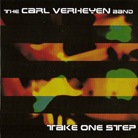 Carl Verheyen is one hell of
a guitarist. He and his band play intellectually funky and jazzy rock that sounds like a
joint recording session by Steely Dan and Gentle Giant. Often Verheyen’s band is just
guitar, bass, and drums, but Jim Cox’s Hammond B-3 organ is occasionally tossed in,
to very good effect. Verheyen wrote most of the music, and sings vocals on seven of the
disc’s ten tracks. There’s a lot of energy here, and a lot of subtlety and
lyricism as well. In the AIX tradition, every note has been flawlessly recorded. The use
of many guitars, manufactured from 1958 to 2004 and listed in the liner notes, sets up a
multitude of timbres throughout this disc, enriched by a varied drum set and focused bass.
It is all clear and clean on this recording -- no guessing "what sound was
that?," which can often be an unwelcome game on heavily scored discs. The set is
packaged a little different than most AIX recordings. In its SACD-type jewel box, the
Enhanced CD and combination DVD-V/A share the same spindle. The DVD is dual-layered and
one-sided -- you don’t have to flip it. Instead of AIX’s usual filmed session of
each song, there’s a 50-minute documentary on the writing of the songs and the
assembly of the album. The video is awful: too red, blotchy, and lacking definition, even
when upsampled by the miraculous Toshiba HD-XA1 HD DVD player. But that won’t matter
much. You might watch the documentary once, but you’ll play the music in your
DVD-Audio player repeatedly. Carl Verheyen is one hell of
a guitarist. He and his band play intellectually funky and jazzy rock that sounds like a
joint recording session by Steely Dan and Gentle Giant. Often Verheyen’s band is just
guitar, bass, and drums, but Jim Cox’s Hammond B-3 organ is occasionally tossed in,
to very good effect. Verheyen wrote most of the music, and sings vocals on seven of the
disc’s ten tracks. There’s a lot of energy here, and a lot of subtlety and
lyricism as well. In the AIX tradition, every note has been flawlessly recorded. The use
of many guitars, manufactured from 1958 to 2004 and listed in the liner notes, sets up a
multitude of timbres throughout this disc, enriched by a varied drum set and focused bass.
It is all clear and clean on this recording -- no guessing "what sound was
that?," which can often be an unwelcome game on heavily scored discs. The set is
packaged a little different than most AIX recordings. In its SACD-type jewel box, the
Enhanced CD and combination DVD-V/A share the same spindle. The DVD is dual-layered and
one-sided -- you don’t have to flip it. Instead of AIX’s usual filmed session of
each song, there’s a 50-minute documentary on the writing of the songs and the
assembly of the album. The video is awful: too red, blotchy, and lacking definition, even
when upsampled by the miraculous Toshiba HD-XA1 HD DVD player. But that won’t matter
much. You might watch the documentary once, but you’ll play the music in your
DVD-Audio player repeatedly.
Haydn: Symphony 88, "The Letter V"; Symphony
101, "The Clock"; L’sola Disabitata Overture
Austro-Hungarian Haydn Symphony; Adám Fischer, conductor.
MDG 901 1441, Hybrid Multichannel SACD.
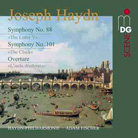 Adám Fischer has recorded this music
before, with the same orchestra, in his complete set of all of Haydn’s symphonies for
Nimbus. He’s also recorded Haydn’s symphonies 92 and 94 for MD&G. This
second MD&G disc of Haydn symphonies raises the hope of another complete cycle, for
now Fischer’s readings are even livelier. The first and second movements of
symphonies 88 and 101 are considerably faster than in the earlier recordings, while the
third and fourth movements are about the same. These are elegant, refined, and attentive
readings; not a single detail is overlooked, and the overall mood is one of joy. Haydn
loved to play musical tricks by using phase modulations or abrupt changes in dynamics, or
by playing ideas against each other, such as writing birdcalls for the woodwinds in the
middle of an elegant slow movement. Fischer doesn’t miss a trick, and his players
respond, to the man and woman. Though the recording locations were the same, this MD&G
release has more sparkle, focus, and presence than the Nimbus version. All of the
instrumental doublings are remarkably clear, and the balance of the brass and timpani with
the rest of the orchestra is exemplary. The rear channels add just the right amount of
hall ambience. This disc is a winner in every respect. Adám Fischer has recorded this music
before, with the same orchestra, in his complete set of all of Haydn’s symphonies for
Nimbus. He’s also recorded Haydn’s symphonies 92 and 94 for MD&G. This
second MD&G disc of Haydn symphonies raises the hope of another complete cycle, for
now Fischer’s readings are even livelier. The first and second movements of
symphonies 88 and 101 are considerably faster than in the earlier recordings, while the
third and fourth movements are about the same. These are elegant, refined, and attentive
readings; not a single detail is overlooked, and the overall mood is one of joy. Haydn
loved to play musical tricks by using phase modulations or abrupt changes in dynamics, or
by playing ideas against each other, such as writing birdcalls for the woodwinds in the
middle of an elegant slow movement. Fischer doesn’t miss a trick, and his players
respond, to the man and woman. Though the recording locations were the same, this MD&G
release has more sparkle, focus, and presence than the Nimbus version. All of the
instrumental doublings are remarkably clear, and the balance of the brass and timpani with
the rest of the orchestra is exemplary. The rear channels add just the right amount of
hall ambience. This disc is a winner in every respect.
Ravel: Daphnis et Chloé Suites 1 & 2; Ma
mère l’oye; Bolero
Royal Concertgebouw Orchestra, Amsterdam; Bernard Haitink, conductor.
PentaTone 5186 167, Hybrid Multichannel SACD.
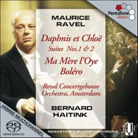 In the 1970s, the Royal Concertgebouw
Orchestra was among the top ten orchestras of the world. Bernard Haitink had been music
director long enough that the musicians knew exactly what he wanted, and could deliver it
with passion and elegance. This disc gives us performances of Ravel’s music that
shimmer -- not icily or distantly, but in a warm and immediate way. Tempos are well chosen
-- Bolero is on the faster side for that piece -- and the recording is luminous.
The bass is solid yet not overdone, the woodwinds sparkle without becoming brittle, the
strings have that sweet "anamorphic" sound that vinyl lovers defend, the brass
section is dark and solid, and the percussion instruments have great presence while still
sounding in proper balance. The near-perfect acoustics of the Concertgebouw are made solid
by the discreet use of the surrounds in this 4.0-channel recording. The Philips engineers
of the 1970s were visionaries, setting today’s standard more than 30 years ago. In the 1970s, the Royal Concertgebouw
Orchestra was among the top ten orchestras of the world. Bernard Haitink had been music
director long enough that the musicians knew exactly what he wanted, and could deliver it
with passion and elegance. This disc gives us performances of Ravel’s music that
shimmer -- not icily or distantly, but in a warm and immediate way. Tempos are well chosen
-- Bolero is on the faster side for that piece -- and the recording is luminous.
The bass is solid yet not overdone, the woodwinds sparkle without becoming brittle, the
strings have that sweet "anamorphic" sound that vinyl lovers defend, the brass
section is dark and solid, and the percussion instruments have great presence while still
sounding in proper balance. The near-perfect acoustics of the Concertgebouw are made solid
by the discreet use of the surrounds in this 4.0-channel recording. The Philips engineers
of the 1970s were visionaries, setting today’s standard more than 30 years ago.
Michel Camilo: Spirit of the Moment
Telarc 63653, Hybrid Multichannel SACD.
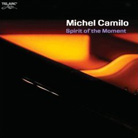 Michel Camilo’s new disc
is strongly Latin-flavored, and his new trio includes an old friend, bassist Charles
Flores, and a new drummer, Dafnis Prieto. Flores often bows his bass, and Prieto has a
large collection of cymbals and sticks. The result is music that is laid-back but urgent.
The complex "My Secret Place" and "Spirit of the Moment" let us know
that each of these three men was classically trained. Like most of the tunes here, these
are Camilo originals, but Camilo and his two fellow players also pay homage to their
elders, in performances of John Coltrane’s "Giant Steps," Wayne
Shorter’s "Nefertiti," and Miles Davis’s "Solar." The sound
is as good as any that Telarc has ever produced, which is saying something. Each
instrument has presence and individual space, but the players never sound separated. The
intricate interplay among the three is caught perfectly in a recording that is clear and
never sounds manipulated; wisely, the Telarc engineers have left that up to the players.
This will be a great album to listen to while sitting on the deck sipping iced herbal tea:
mellow, but with just the right amount of bite. Michel Camilo’s new disc
is strongly Latin-flavored, and his new trio includes an old friend, bassist Charles
Flores, and a new drummer, Dafnis Prieto. Flores often bows his bass, and Prieto has a
large collection of cymbals and sticks. The result is music that is laid-back but urgent.
The complex "My Secret Place" and "Spirit of the Moment" let us know
that each of these three men was classically trained. Like most of the tunes here, these
are Camilo originals, but Camilo and his two fellow players also pay homage to their
elders, in performances of John Coltrane’s "Giant Steps," Wayne
Shorter’s "Nefertiti," and Miles Davis’s "Solar." The sound
is as good as any that Telarc has ever produced, which is saying something. Each
instrument has presence and individual space, but the players never sound separated. The
intricate interplay among the three is caught perfectly in a recording that is clear and
never sounds manipulated; wisely, the Telarc engineers have left that up to the players.
This will be a great album to listen to while sitting on the deck sipping iced herbal tea:
mellow, but with just the right amount of bite.
Grieg: Olav Trygvason; Foran Sydens Kloster
(At the Cloister’s Gate); Six Songs with Orchestra; Ved Rondane
Marita Solberg, Solveig Kringelborn, sopranos; Ingebjørg Kosmo, mezzo-soprano; Bergen
Philharmonic Choir, Bergen Philharmonic; Ole Kristian Ruud, conductor.
BIS 1531, Hybrid Multichannel SACD.
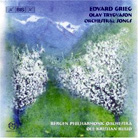 Edvard Grieg was one of the supreme
melodists in music history, yet his vocal and choral works are seldom performed. Having
recorded Grieg’s most significant orchestral music, conductor Ole Kristian Ruud
continues his definitive SACD series of Grieg’s music by turning his attention to
this neglected music. In the early 1870s, Grieg and Bjørnstjerne Bjørnson decided to
write an opera together. Grieg did not want to as much to collaborate as to write music to
the texts sent to him. But after delivering the first three scenes, Bjørnson stopped
writing, and Grieg stopped as well. The two wanted to avoid references to Wagner, but much
of the music is reminiscent of that composer. The beginning of the third scene, however,
contains music that sounds more than a little bit like "In the Hall of the Mountain
King," from Grieg’s masterpiece, Peer Gynt. The Six Songs with
Orchestra include two from that work, "Solveig’s Song" and "Cradle
Song," sung with warmth and feeling by mezzo-soprano Ingebjørg Kosmo. As usual with
BIS, Grieg, and Ruud, the recording is sumptuous, warm, and detailed, with just the right
amount of rear-channel information. The balance of voices and orchestra is exemplary. Edvard Grieg was one of the supreme
melodists in music history, yet his vocal and choral works are seldom performed. Having
recorded Grieg’s most significant orchestral music, conductor Ole Kristian Ruud
continues his definitive SACD series of Grieg’s music by turning his attention to
this neglected music. In the early 1870s, Grieg and Bjørnstjerne Bjørnson decided to
write an opera together. Grieg did not want to as much to collaborate as to write music to
the texts sent to him. But after delivering the first three scenes, Bjørnson stopped
writing, and Grieg stopped as well. The two wanted to avoid references to Wagner, but much
of the music is reminiscent of that composer. The beginning of the third scene, however,
contains music that sounds more than a little bit like "In the Hall of the Mountain
King," from Grieg’s masterpiece, Peer Gynt. The Six Songs with
Orchestra include two from that work, "Solveig’s Song" and "Cradle
Song," sung with warmth and feeling by mezzo-soprano Ingebjørg Kosmo. As usual with
BIS, Grieg, and Ruud, the recording is sumptuous, warm, and detailed, with just the right
amount of rear-channel information. The balance of voices and orchestra is exemplary.
...Rad Bennett
radb@ultraaudio.com

All contents copyright Schneider Publishing Inc., all rights
reserved.
Any reproduction, without permission, is prohibited.
Ultra Audio is part of the SoundStage! Network.
A world of websites and publications for audio, video, music, and movie enthusiasts. |

 In the early 20th century, many
famous pianists made piano-roll recordings of their versions of familiar masterworks, many
of which were copied to LP and, later, to CD, using modern player pianos and high-fidelity
recording techniques. Two of the best of these CDs, released by Telarc a few years ago,
captured Rachmaninoff playing his own music and that of others. Advanced transfer
techniques permitted nuances in the playing that defied the basic logic of merely
duplicating piano-roll performance on CD.
In the early 20th century, many
famous pianists made piano-roll recordings of their versions of familiar masterworks, many
of which were copied to LP and, later, to CD, using modern player pianos and high-fidelity
recording techniques. Two of the best of these CDs, released by Telarc a few years ago,
captured Rachmaninoff playing his own music and that of others. Advanced transfer
techniques permitted nuances in the playing that defied the basic logic of merely
duplicating piano-roll performance on CD.  Based on Fritz Reiner’s few
recordings of Spanish music, the Hungarian-born conductor had a real flair for Spanish
rhythms and colors: these performances sizzle. I’ve always felt that Spain,
recorded in 1958, was one of the very best-sounding of RCA’s distinguished Living
Stereo sessions, and hearing it in this first-ever release of its original three-channel
master confirms that impression. The orchestra is spread naturally from left to right,
with good stage depth. Yet every instrument, no matter how close to or how far from a
microphone, has undeniable presence. The strings sound warm (purists might say they sound
"analog," with lots of air around them), and the various percussion instruments
employed come through with singular clarity. Falla’s El Amor Brujo, recorded
in 1963, is no less successful. Leontyne Price’s fiery singing is locked mostly in
the center channel, which allows the orchestral parts more clarity than usual. This SACD
proved ideal to heat up a snowy day, but it would be great to hear in any season. My only
regret is that Reiner recorded just three excerpts from Ibéria and not the whole
suite.
Based on Fritz Reiner’s few
recordings of Spanish music, the Hungarian-born conductor had a real flair for Spanish
rhythms and colors: these performances sizzle. I’ve always felt that Spain,
recorded in 1958, was one of the very best-sounding of RCA’s distinguished Living
Stereo sessions, and hearing it in this first-ever release of its original three-channel
master confirms that impression. The orchestra is spread naturally from left to right,
with good stage depth. Yet every instrument, no matter how close to or how far from a
microphone, has undeniable presence. The strings sound warm (purists might say they sound
"analog," with lots of air around them), and the various percussion instruments
employed come through with singular clarity. Falla’s El Amor Brujo, recorded
in 1963, is no less successful. Leontyne Price’s fiery singing is locked mostly in
the center channel, which allows the orchestral parts more clarity than usual. This SACD
proved ideal to heat up a snowy day, but it would be great to hear in any season. My only
regret is that Reiner recorded just three excerpts from Ibéria and not the whole
suite. Carl Verheyen is one hell of
a guitarist. He and his band play intellectually funky and jazzy rock that sounds like a
joint recording session by Steely Dan and Gentle Giant. Often Verheyen’s band is just
guitar, bass, and drums, but Jim Cox’s Hammond B-3 organ is occasionally tossed in,
to very good effect. Verheyen wrote most of the music, and sings vocals on seven of the
disc’s ten tracks. There’s a lot of energy here, and a lot of subtlety and
lyricism as well. In the AIX tradition, every note has been flawlessly recorded. The use
of many guitars, manufactured from 1958 to 2004 and listed in the liner notes, sets up a
multitude of timbres throughout this disc, enriched by a varied drum set and focused bass.
It is all clear and clean on this recording -- no guessing "what sound was
that?," which can often be an unwelcome game on heavily scored discs. The set is
packaged a little different than most AIX recordings. In its SACD-type jewel box, the
Enhanced CD and combination DVD-V/A share the same spindle. The DVD is dual-layered and
one-sided -- you don’t have to flip it. Instead of AIX’s usual filmed session of
each song, there’s a 50-minute documentary on the writing of the songs and the
assembly of the album. The video is awful: too red, blotchy, and lacking definition, even
when upsampled by the miraculous Toshiba HD-XA1 HD DVD player. But that won’t matter
much. You might watch the documentary once, but you’ll play the music in your
DVD-Audio player repeatedly.
Carl Verheyen is one hell of
a guitarist. He and his band play intellectually funky and jazzy rock that sounds like a
joint recording session by Steely Dan and Gentle Giant. Often Verheyen’s band is just
guitar, bass, and drums, but Jim Cox’s Hammond B-3 organ is occasionally tossed in,
to very good effect. Verheyen wrote most of the music, and sings vocals on seven of the
disc’s ten tracks. There’s a lot of energy here, and a lot of subtlety and
lyricism as well. In the AIX tradition, every note has been flawlessly recorded. The use
of many guitars, manufactured from 1958 to 2004 and listed in the liner notes, sets up a
multitude of timbres throughout this disc, enriched by a varied drum set and focused bass.
It is all clear and clean on this recording -- no guessing "what sound was
that?," which can often be an unwelcome game on heavily scored discs. The set is
packaged a little different than most AIX recordings. In its SACD-type jewel box, the
Enhanced CD and combination DVD-V/A share the same spindle. The DVD is dual-layered and
one-sided -- you don’t have to flip it. Instead of AIX’s usual filmed session of
each song, there’s a 50-minute documentary on the writing of the songs and the
assembly of the album. The video is awful: too red, blotchy, and lacking definition, even
when upsampled by the miraculous Toshiba HD-XA1 HD DVD player. But that won’t matter
much. You might watch the documentary once, but you’ll play the music in your
DVD-Audio player repeatedly. Adám Fischer has recorded this music
before, with the same orchestra, in his complete set of all of Haydn’s symphonies for
Nimbus. He’s also recorded Haydn’s symphonies 92 and 94 for MD&G. This
second MD&G disc of Haydn symphonies raises the hope of another complete cycle, for
now Fischer’s readings are even livelier. The first and second movements of
symphonies 88 and 101 are considerably faster than in the earlier recordings, while the
third and fourth movements are about the same. These are elegant, refined, and attentive
readings; not a single detail is overlooked, and the overall mood is one of joy. Haydn
loved to play musical tricks by using phase modulations or abrupt changes in dynamics, or
by playing ideas against each other, such as writing birdcalls for the woodwinds in the
middle of an elegant slow movement. Fischer doesn’t miss a trick, and his players
respond, to the man and woman. Though the recording locations were the same, this MD&G
release has more sparkle, focus, and presence than the Nimbus version. All of the
instrumental doublings are remarkably clear, and the balance of the brass and timpani with
the rest of the orchestra is exemplary. The rear channels add just the right amount of
hall ambience. This disc is a winner in every respect.
Adám Fischer has recorded this music
before, with the same orchestra, in his complete set of all of Haydn’s symphonies for
Nimbus. He’s also recorded Haydn’s symphonies 92 and 94 for MD&G. This
second MD&G disc of Haydn symphonies raises the hope of another complete cycle, for
now Fischer’s readings are even livelier. The first and second movements of
symphonies 88 and 101 are considerably faster than in the earlier recordings, while the
third and fourth movements are about the same. These are elegant, refined, and attentive
readings; not a single detail is overlooked, and the overall mood is one of joy. Haydn
loved to play musical tricks by using phase modulations or abrupt changes in dynamics, or
by playing ideas against each other, such as writing birdcalls for the woodwinds in the
middle of an elegant slow movement. Fischer doesn’t miss a trick, and his players
respond, to the man and woman. Though the recording locations were the same, this MD&G
release has more sparkle, focus, and presence than the Nimbus version. All of the
instrumental doublings are remarkably clear, and the balance of the brass and timpani with
the rest of the orchestra is exemplary. The rear channels add just the right amount of
hall ambience. This disc is a winner in every respect. In the 1970s, the Royal Concertgebouw
Orchestra was among the top ten orchestras of the world. Bernard Haitink had been music
director long enough that the musicians knew exactly what he wanted, and could deliver it
with passion and elegance. This disc gives us performances of Ravel’s music that
shimmer -- not icily or distantly, but in a warm and immediate way. Tempos are well chosen
-- Bolero is on the faster side for that piece -- and the recording is luminous.
The bass is solid yet not overdone, the woodwinds sparkle without becoming brittle, the
strings have that sweet "anamorphic" sound that vinyl lovers defend, the brass
section is dark and solid, and the percussion instruments have great presence while still
sounding in proper balance. The near-perfect acoustics of the Concertgebouw are made solid
by the discreet use of the surrounds in this 4.0-channel recording. The Philips engineers
of the 1970s were visionaries, setting today’s standard more than 30 years ago.
In the 1970s, the Royal Concertgebouw
Orchestra was among the top ten orchestras of the world. Bernard Haitink had been music
director long enough that the musicians knew exactly what he wanted, and could deliver it
with passion and elegance. This disc gives us performances of Ravel’s music that
shimmer -- not icily or distantly, but in a warm and immediate way. Tempos are well chosen
-- Bolero is on the faster side for that piece -- and the recording is luminous.
The bass is solid yet not overdone, the woodwinds sparkle without becoming brittle, the
strings have that sweet "anamorphic" sound that vinyl lovers defend, the brass
section is dark and solid, and the percussion instruments have great presence while still
sounding in proper balance. The near-perfect acoustics of the Concertgebouw are made solid
by the discreet use of the surrounds in this 4.0-channel recording. The Philips engineers
of the 1970s were visionaries, setting today’s standard more than 30 years ago. Michel Camilo’s new disc
is strongly Latin-flavored, and his new trio includes an old friend, bassist Charles
Flores, and a new drummer, Dafnis Prieto. Flores often bows his bass, and Prieto has a
large collection of cymbals and sticks. The result is music that is laid-back but urgent.
The complex "My Secret Place" and "Spirit of the Moment" let us know
that each of these three men was classically trained. Like most of the tunes here, these
are Camilo originals, but Camilo and his two fellow players also pay homage to their
elders, in performances of John Coltrane’s "Giant Steps," Wayne
Shorter’s "Nefertiti," and Miles Davis’s "Solar." The sound
is as good as any that Telarc has ever produced, which is saying something. Each
instrument has presence and individual space, but the players never sound separated. The
intricate interplay among the three is caught perfectly in a recording that is clear and
never sounds manipulated; wisely, the Telarc engineers have left that up to the players.
This will be a great album to listen to while sitting on the deck sipping iced herbal tea:
mellow, but with just the right amount of bite.
Michel Camilo’s new disc
is strongly Latin-flavored, and his new trio includes an old friend, bassist Charles
Flores, and a new drummer, Dafnis Prieto. Flores often bows his bass, and Prieto has a
large collection of cymbals and sticks. The result is music that is laid-back but urgent.
The complex "My Secret Place" and "Spirit of the Moment" let us know
that each of these three men was classically trained. Like most of the tunes here, these
are Camilo originals, but Camilo and his two fellow players also pay homage to their
elders, in performances of John Coltrane’s "Giant Steps," Wayne
Shorter’s "Nefertiti," and Miles Davis’s "Solar." The sound
is as good as any that Telarc has ever produced, which is saying something. Each
instrument has presence and individual space, but the players never sound separated. The
intricate interplay among the three is caught perfectly in a recording that is clear and
never sounds manipulated; wisely, the Telarc engineers have left that up to the players.
This will be a great album to listen to while sitting on the deck sipping iced herbal tea:
mellow, but with just the right amount of bite. Edvard Grieg was one of the supreme
melodists in music history, yet his vocal and choral works are seldom performed. Having
recorded Grieg’s most significant orchestral music, conductor Ole Kristian Ruud
continues his definitive SACD series of Grieg’s music by turning his attention to
this neglected music. In the early 1870s, Grieg and Bjørnstjerne Bjørnson decided to
write an opera together. Grieg did not want to as much to collaborate as to write music to
the texts sent to him. But after delivering the first three scenes, Bjørnson stopped
writing, and Grieg stopped as well. The two wanted to avoid references to Wagner, but much
of the music is reminiscent of that composer. The beginning of the third scene, however,
contains music that sounds more than a little bit like "In the Hall of the Mountain
King," from Grieg’s masterpiece, Peer Gynt. The Six Songs with
Orchestra include two from that work, "Solveig’s Song" and "Cradle
Song," sung with warmth and feeling by mezzo-soprano Ingebjørg Kosmo. As usual with
BIS, Grieg, and Ruud, the recording is sumptuous, warm, and detailed, with just the right
amount of rear-channel information. The balance of voices and orchestra is exemplary.
Edvard Grieg was one of the supreme
melodists in music history, yet his vocal and choral works are seldom performed. Having
recorded Grieg’s most significant orchestral music, conductor Ole Kristian Ruud
continues his definitive SACD series of Grieg’s music by turning his attention to
this neglected music. In the early 1870s, Grieg and Bjørnstjerne Bjørnson decided to
write an opera together. Grieg did not want to as much to collaborate as to write music to
the texts sent to him. But after delivering the first three scenes, Bjørnson stopped
writing, and Grieg stopped as well. The two wanted to avoid references to Wagner, but much
of the music is reminiscent of that composer. The beginning of the third scene, however,
contains music that sounds more than a little bit like "In the Hall of the Mountain
King," from Grieg’s masterpiece, Peer Gynt. The Six Songs with
Orchestra include two from that work, "Solveig’s Song" and "Cradle
Song," sung with warmth and feeling by mezzo-soprano Ingebjørg Kosmo. As usual with
BIS, Grieg, and Ruud, the recording is sumptuous, warm, and detailed, with just the right
amount of rear-channel information. The balance of voices and orchestra is exemplary.